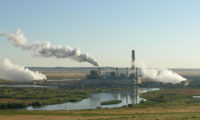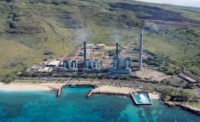Some 450 construction workers are converging on a site in Pardeeville, Wis., to convert the state's largest source of sulfur dioxide (SO2) and mercury pollution into a poster child for cleaner, greener emissions. Peak periods will push the number of workers on site past 600 as crews assemble an air-quality control system and the facilities required to house it at Columbia Energy Center, a coal-fired electrical station undergoing $627 million in upgrades, including construction of SO2 and mercury-reduction systems.
"There isn't time to complete one activity before beginning work on another," says Steve Pieschl, project director with Overland Park, Kan.-based Black & Veatch, the project's designer and builder. As a result, work is overlapping. "We'll complete structural steel by August and equipment construction by the end of the year," says Pieschl.
Crews will soon begin assembly of a pair of induced draft booster fans that will assist in the discharge of plant emissions, once gases have been cleansed by new spray-dryer absorbers, or scrubbers, and pulse-jet filters, or baghouses, currently under construction on site. Installation of the fans will occur as crews complete construction of the 40-ft by 80-ft steel-framed structures that enclose them.
"We'll erect the first layer of structural steel, then install the bottom half of the fan, followed by a second layer of structural steel, then the top half of the fan," says Pieschl.
"Induced-draft fans typically pull air and gas through combustion, a boiler, precipitators and so forth before discharging through a stack," Pieschl says. "The booster fans will offset a pressure drop caused by installation of the new equipment."
Plant operator and majority owner Wisconsin Power & Light (WP&L) broke ground on the project in early 2012 and must complete upgrades by January 2015, when new state environmental regulations take effect. Once work is complete, the plant's two coal-burning units—Columbia 1 and 2—each will achieve a 90% reduction in SO2 and mercury emissions.
In addition to spray-dryer absorbers to contend with SO2 emissions, and an activated carbon injection system to deal with mercury emissions, plans call for the construction of associated electrical, waste storage and limestone preparation facilities, as well as the baghouses and fan facilities.
Once construction is complete, flue gas will bypass existing exhaust chimneys and be treated by spray dryers, jet-fabric filters and carbon injection before being routed back to the chimneys and released into the atmosphere. Among other tasks, plans call for construction of large amounts of ductwork to funnel the gas from one location to the next.
"It's an extremely complex project," says Pieschl, adding that the work has numerous moving parts.
While Black & Veatch is assuming responsibility for designing and erecting the booster fans, waste-handling equipment, power-distribution systems, controls and new buildings, it contracted with Barberton, Ohio-based Babcock & Wilcox Power Generation Group to design, supply and construct the spray-dryer absorbers, pulse-jet fabric filters, lime and recycled ash systems, process piping and related structural steel.






Post a comment to this article
Report Abusive Comment